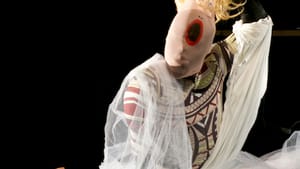Stay in the Loop
BSR publishes on a weekly schedule, with an email newsletter every Wednesday and Thursday morning. There’s no paywall, and subscribing is always free.
The medium and the message
FringeArts presents Jaamil Olawale Kosoko’s 'Séancers'

FringeArts opened Jaamil Olawale Kosoko’s enthralling Séancers this week, an elaboration on themes explored in his 2016 #negrophobia. The piece is at once an essay, a ritual, and a performance of community. Aspiring to nothing less than finding an antidote to black erasure, Kosoko serves as the primary medium of this séance.
Channeling a formidable range of black voices — living, dead, brilliant, broken, fabulous, and mutilated — he invites spectators to locate themselves in this constellation.
#negrophobia, created shortly after Kosoko's younger brother was stabbed to death, dealt with violence against black men in America and pulsated with its creator’s raw personal loss. That pain still remains in Séancers, but this work is oriented toward healing, reclamation, and restoration.
No place to hide
Kosoko is present as the audience finds their seats. He wears mirrored aviator sunglasses and a boldly patterned unitard under a shimmering peignoir, but his manner is casual, congenial, and inviting. He banters easily with people as they arrive, warmly greeting those he knows by name.
FringeArts' theater is downsized for this occasion to accommodate only an intimate group. If Kosoko feels like reaching out to touch you, there is no place to hide. But he usually asks for permission.
This informal beginning sets a mood pregnant with expectation and trepidation — perfect for a prelude to a paranormal event. All boundaries seem permeable, including the one between what does and does not constitute the performance.
When the audience settles in, Kosoko introduces the evening’s “guest séancer,” a different theorist every performance, who serves as interlocutor and helps frame the piece. On the night I attended, this role was assumed by Brenda Dixon Gottschild, author of The Black Dancing Body (2003). Gottschild’s intervention entailed glossing the concept of Négritude, an anticolonial strategy for affirming black power and beauty. She also extolled the virtues of Nigerian writer Wole Soyinka, and pointed out that she, Soyinka, and Nigerian-American Kosoko share a common heritage.

Hidden treasure
With this rich web of associations present in the room, the séance begins. Aided by composer Jeremy Toussaint-Baptiste’s restless, murmuring score, Kosoko takes us into the spirit world. He recites Audre Lorde’s 1978 poem “Power.” He conjures the voice of his schizophrenic mother keening that she wants “to be somebody else.” He sings and dances, chaotically cycling through iterations of an identity drawing from many sources, black and white, mostly female.
Wigs, costume pieces, and props are pulled on and discarded into a tangled mass of tulle and plastic pom-pom strips big enough to completely envelop Kosoko. A charred white dress, a mask, an oversized human skull, and a (white) dildo stand out.
Much of this detritus, however, is too well obscured to communicate meaning to the audience, or even make a claim on our attention. For example, my companion didn’t notice a shackle among the rest of the material until we were leaving the theater. Other objects seem to be included for private reasons, perhaps for their talismanic value.
Yet this abstruseness enhances the performance rather than detracting from it. The audience is here to witness; our medium makes himself available for infiltration, opening himself up to authentic emotion without “acting” anything out for us. While Kosoko’s performance style is unsettling and occasionally exasperating, it is truly a privilege to be in the presence of this rare kind of attunement.
As Séancers concludes, Kosoko frantically lip-syncs to the impassioned, recorded voice of civil rights activist Ruby Sales. “How do we develop a theology,” she asks as Kosoko mouths the words, eyes wide, trembling, “in a 21st-century capitalist technocracy where only a few lives matter? How do we raise people up from disposability to essentiality?”
This powerful finale is that much more provocative because Kosoko neither offers an answer to these questions nor proposes a solution to America’s spiritual crisis. He simply leaves the stage, letting the audience wait in uneasy silence, wondering if the performance has really ended, wondering what happens now.
When he finally returns to release us by taking a curtain call, closure still feels a long way off.
[Editor's note: Kosoko is a past contributor to Broad Street Review.]
What, When, Where
Séancers. Created and Performed by Jaamil Olawale Kosoko. Through May 12, 2018, at FringeArts, 140 N. Columbus Boulevard, Philadelphia. (215) 413-1318 or fringearts.com.
Sign up for our newsletter
All of the week's new articles, all in one place. Sign up for the free weekly BSR newsletters, and don't miss a conversation.
 Jessica Rizzo
Jessica Rizzo